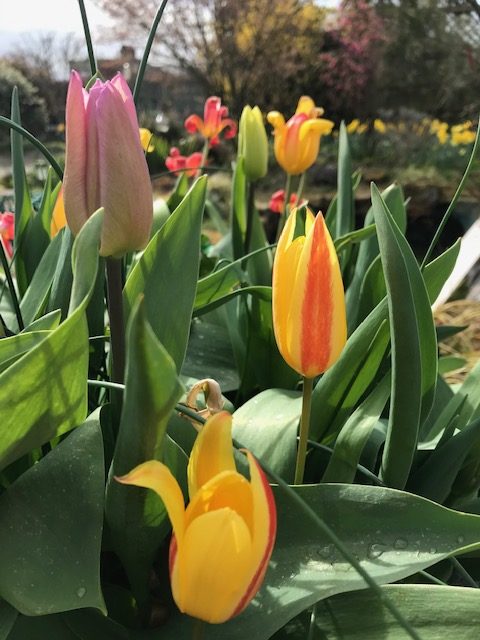No prizes for guessing the topic for this month’s blog – viruses. As we are all adjusting to unprecedented life changes caused by the Coronavirus (also called Covid-19) pandemic, it seemed appropriate to share some words and links about plant viruses and their impact on plant health. This won’t all be a doom and gloom blog though, the devastation that viruses can cause to life is real to us all now. Instead the focus will be on some of the amazing science and networks of people who work on plant viruses and plant health. This blog relates to numbers 4 and 5 of the FAO’s IYPH key messages https://celiaknightconsulting.co.uk/international-year-of-plant-health-what-does-that-mean-for-me/

Viruses in plants can bring us beauty – stripy colour patterns in tulips were identified in the 16th century and later attributed to the tulip-breaking virus. Viruses can influence whether the petal develops colour or not. The red stripe on the yellow flower in this picture demonstrates the effect (also called a phenotype); however most tulips are bred now for colour variation. This observation of the natural world has been studied in many ways e.g. scientists have used the plant to isolate and study the virus and also used the effect of the virus on the flower to study flower development.

One of the UK’s leading plant virologists is Professor George Lomonossoff of the John Innes Centre in Norwich. The work of his research team and collaborators over decades has taken several twists and turns. Excitingly, in the last decade it has led to the possibility of using virus-like particles to produce vaccines (including against human disease) within plants and this is the focus of a new company Leaf Expression Systems. I’ve known George since working at the John Innes Centre in the 1980s. Here he is as an invited speaker at the Gatsby Plant Science Summer School in 2019; my leafy top chosen especially to honour his Leaf Expression work! You can watch his talk here https://www.youtube.com/watch?v=pzJ_mILGYL8 and further detail on the history of virus research at the John Innes Centre can be found here https://www.jic.ac.uk/virology-research-timeline/
So are plant viruses really damaging to plants? Well, they don’t normally kill their host but they can seriously impact the economic value of crops, reducing fertility, yield or simply by producing blemishes on food that makes them unsaleable. This free training module produced by colleagues at Fera Science Ltd in association with the Horticultural Trade Association gives more information https://planthealthy.org.uk/resources/training-module-2-harmful-organisms-pest-risk-analysis and there’s more detail in this recent book https://global.oup.com/academic/product/plant-diseases-and-biosecurity-9780198827726?lang=en&cc=se
There’s another important element to know about plant viruses and plant health and that’s the vector that transmits the virus between plants. We all now understand through the Coronavirus pandemic that the virus spreads by contact between humans. How does this work for plants which are rooted to one spot? This is where insects as vectors are key players, they feed on virus-infected plants and transmit the virus to many other plants. This is Biology, where species interact; viruses, insects, plants. If an interaction is detrimental, it impacts on humans and other species.

This is keenly felt currently in Africa. One international research network is the Virus-Vector Connected Network https://www.connectedvirus.net and I had the pleasure of contributing to a workshop run by them last summer for African scientists at The University of Bristol.
This is the upbeat point to conclude this blog. This event was a wonderfully positive occasion. These scientists from across Africa and a few from other countries know the devastation that viruses can have on plant health. They were eager to learn and use the technical advances that the UK and international research community have available and are continuing to develop and to share their knowledge and expertise in coping with plant disease. Learning how to disseminate and implement solutions also has challenges but where there is communication, tolerance, respect and kindness, there can also be success.

Comments 2
Good morning Celia! I enjoyed your blog once again, though my apologies for being late onto it. I recently saw on a bbc website mention of the Spittlebug citizen science scheme as part of Xyllela UK early warning, & am definitely planning to participate. I think its being run by a Sussex Uni group but under a project called Brigit? In fact I remember noticing lots of spittlebugs around this area last year – cant remember exactly where (possibly our hedges) though so will need to look out for them specifically. I read they’re supposed to be particularly numerous in this area of the South, which I suspect puts us at highest risk of seeing the disease. Oh dear – you’re right that we don’t need even more bad virus news – and we’ve just planted a colourful row of lavender!
Author
Thanks for your comments Allan. Yes the Brigit project is doing good stuff across the UK, coordinated by JIC Norwich (https://www.jic.ac.uk/press-release/uk-wide-consortium-to-combat-serious-threat-to-plant-health/) and including Sussex. My April blog will be on gardens – I’ll let you know!